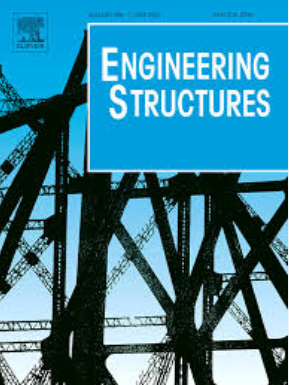Seismic behavior of bridge columns with FRP-reinforced ECC at plastic hinge zones
IF 5.6
1区 工程技术
Q1 ENGINEERING, CIVIL
引用次数: 0
Abstract
The plastic hinge region of bridge columns dissipates seismic energy under earthquakes, effectively constraining the extent of structural damage through localized plastic deformation. To enhance the seismic resilience of this critical region, this study proposes replacing the conventional concrete in the plastic hinge zone with engineered cementitious composite (ECC) and externally wrapping it with fiber-reinforced polymer (FRP). This approach is expected to significantly enhance structural damage tolerance, mitigate longitudinal bar buckling and steel reinforcement corrosion. The seismic performance of this new type of bridge column was investigated via quasi-static tests. The parameters were FRP type (large rupture strain FRP and traditional glass FRP) and the number of FRP layers (1, 2, and 3 layers). The combination of ECC and FRP exhibited outstanding seismic performance in terms of ductility, energy dissipation capacity, and damage control capacity. The existing equivalent plastic hinge length expressions of FRP-confined reinforced concrete (RC) members were evaluated and the proposed formula considering the confinement stiffness for FRP-confined ECC bridge columns delivered more accurate predictions. Nonlinear finite element analysis was performed and was shown to reproduce the hysteretic curves of the column models with acceptable accuracy. A parametric study was conducted to further analyze the effects of the wrapping height of FRP, axial compression ratio, and longitudinal reinforcement ratio on the peak lateral force and ductility of FRP-reinforced ECC bridge columns. Finally, design recommendations were provided for the engineering design of FRP-reinforced ECC structures.
塑性铰区frp加固ECC桥柱的抗震性能
桥梁柱塑性铰区在地震作用下耗散地震能量,通过局部塑性变形有效约束结构的破坏程度。为了提高这一关键区域的抗震能力,本研究建议用工程胶凝复合材料(ECC)取代塑料铰区的传统混凝土,并在其外部包裹纤维增强聚合物(FRP)。这种方法有望显著提高结构的损伤容忍度,减轻纵向钢筋屈曲和钢筋腐蚀。通过拟静力试验对这种新型桥柱的抗震性能进行了研究。参数为玻璃钢类型(大破裂应变玻璃钢和传统玻璃玻璃钢)和玻璃钢层数(1层、2层和3层)。在延性、耗能能力和损伤控制能力方面,ECC与FRP的组合表现出优异的抗震性能。对现有frp约束钢筋混凝土(RC)构件等效塑性铰长度表达式进行了评价,提出的考虑frp约束ECC桥柱约束刚度的等效塑性铰长度公式预测更为准确。进行了非线性有限元分析,并证明了以可接受的精度再现柱模型的滞回曲线。通过参数化研究,进一步分析FRP包覆高度、轴压比、纵向配筋率对FRP加固ECC桥柱峰值侧向力和延性的影响。最后,对frp加固ECC结构的工程设计提出了设计建议。
本文章由计算机程序翻译,如有差异,请以英文原文为准。
求助全文
约1分钟内获得全文
求助全文
来源期刊

Engineering Structures
工程技术-工程:土木
CiteScore
10.20
自引率
14.50%
发文量
1385
审稿时长
67 days
期刊介绍:
Engineering Structures provides a forum for a broad blend of scientific and technical papers to reflect the evolving needs of the structural engineering and structural mechanics communities. Particularly welcome are contributions dealing with applications of structural engineering and mechanics principles in all areas of technology. The journal aspires to a broad and integrated coverage of the effects of dynamic loadings and of the modelling techniques whereby the structural response to these loadings may be computed.
The scope of Engineering Structures encompasses, but is not restricted to, the following areas: infrastructure engineering; earthquake engineering; structure-fluid-soil interaction; wind engineering; fire engineering; blast engineering; structural reliability/stability; life assessment/integrity; structural health monitoring; multi-hazard engineering; structural dynamics; optimization; expert systems; experimental modelling; performance-based design; multiscale analysis; value engineering.
Topics of interest include: tall buildings; innovative structures; environmentally responsive structures; bridges; stadiums; commercial and public buildings; transmission towers; television and telecommunication masts; foldable structures; cooling towers; plates and shells; suspension structures; protective structures; smart structures; nuclear reactors; dams; pressure vessels; pipelines; tunnels.
Engineering Structures also publishes review articles, short communications and discussions, book reviews, and a diary on international events related to any aspect of structural engineering.
 求助内容:
求助内容: 应助结果提醒方式:
应助结果提醒方式:


